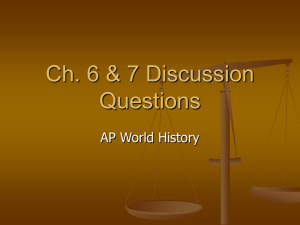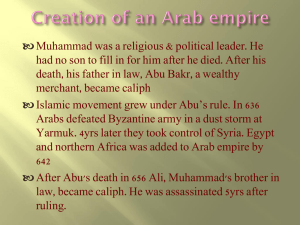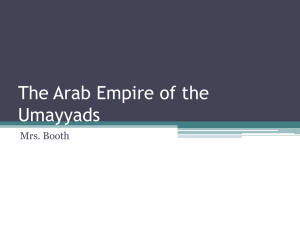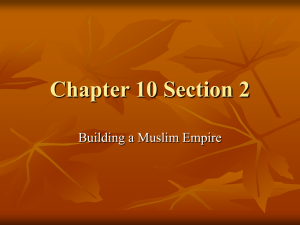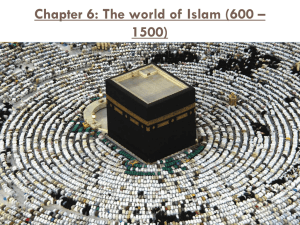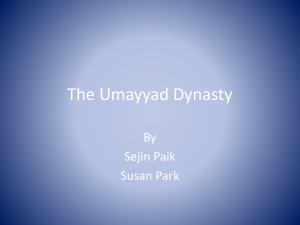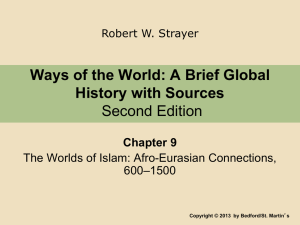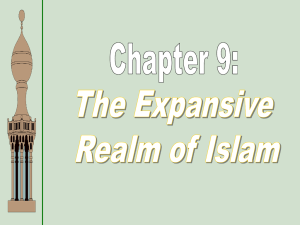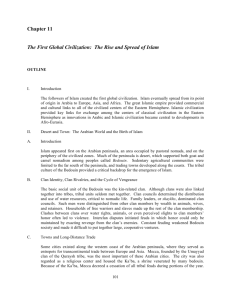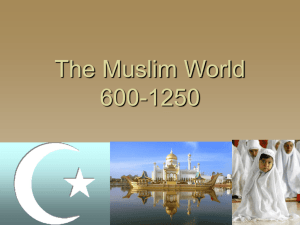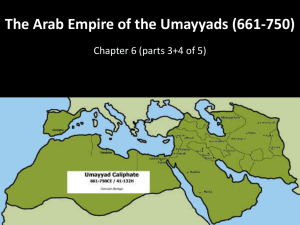chapter 6 powerpoint
advertisement
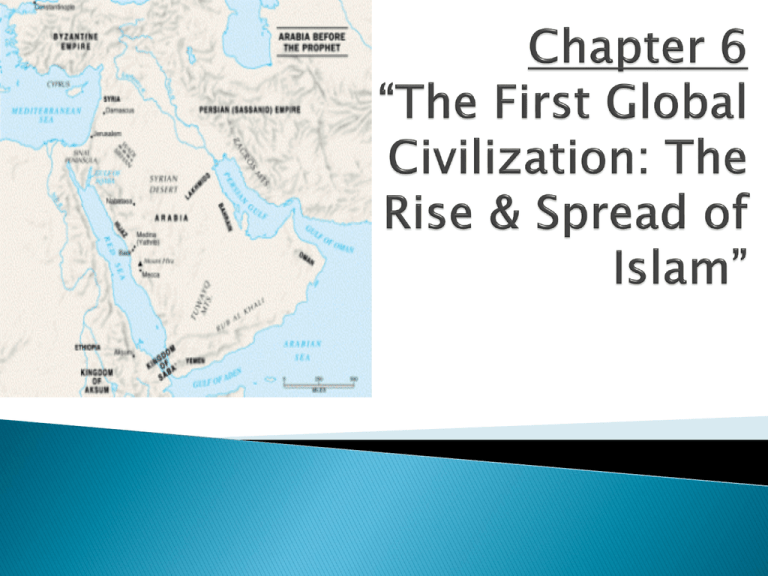
Time period: approx. 450–1450 C.E. Emergence of an “international framework” Civilization begins to spread geographically, now covering many parts of the world not previously embraced by human organization Several new civilizations/areas share key characteristics (ex: eastern & western Europe are primarily Christian societies) Era defined by the spread of major religions across much of Asia, Europe, & Africa ◦ Hinduism = majority religion in India ◦ Buddhism spread to China & parts of central and east Asia (including Japan) ◦ Islam spreads across the Middle East and Northern Africa; also a “minority religion” in India, western China, & SubSaharan Africa Shift from polytheism to monotheism Growth in international trade Technology and ideas spread ◦ Due to growing trade, military encounters, and redefining of boundaries within civilizations Variety of political forms ◦ But no single, dominant political form Creation of a new empire in the “Middle East” and North Africa, as well as parts of India, south Europe, and central Asia Islam – submission; self-surrender of the believer to the will of the one Muslims – followers of the new faith (Islam) and its prophet (Muhammad) Muslim traders & conquerors became the prime agents for the transfer of food crops, technology, and ideas among the many centers of civilization in the Eastern Hemisphere Muslims had works in philosophy, literature, mathematics, and science Quran – the holy book containing Allah’s revelations to Muhammad Islamic world: unified by a common allegiance to the religious teachings of Muhammad and to some extent by the Arabic language divided by political rivalries, cultural & linguistic diversity, and religious sectarianism (excessive devotion to a particular sect, especially in religion) Many bedouin clans helped spread the beliefs of the prophet Muhammad. ◦ Bedouin = nomadic Sheiks (Shaykhs) – leaders of tribes and clans Inter-clan rivalries would lead to wars breaking out Most important city was Mecca (located in mountainous region along the Red Sea and western part of Arabia) ◦ Mecca was founded by the Umayyad clan Northeast of Mecca was Medina – the city of the prophet Muhammad. ◦ Both Medina and Mecca engaged in long distance trading (Mecca more so than Medina); both considered “trade centers” ◦ Control of Medina was contested between 2 bedouin groups and 3 Jewish clans. Women in pre-Islamic bedouin culture enjoyed greater freedom and higher status compared to other civilized centers [Byzantine and Sasanian (Persian) empires]. ◦ Did NOT wear veils and were NOT secluded…at this point in time ◦ Women’s advice was highly regarded ◦ Women AND men were both sometimes allowed to have multiple marriage partners ◦ Still NOT considered equal to men though. ◦ Women’s status varied from one clan/family to the next. Born around 570 C.E. Lived in Mecca during his adolescence Lived/worked as a trader and traveler ◦ Helps him see religious currents sweeping through Arabia, especially the idea of monotheism and a growing dissatisfaction of the old gods. Was socially prominent, economically well off, and admired for his trading skills and trustworthiness Became dissatisfied with life and distracted with a life that focused on material gains. Around 610 C.E. he received his first “revelation” ◦ His following/followers were a small group at first (his wife, several clans people, and some servants and slaves). Eventually has to flee Mecca due to threats from the Umayyads and other clans 622 C.E. – secures safe passage from Mecca to Medina ◦ Given a “hero’s welcome” when in Medina Series of attacks in Medina in mid 620’s C.E. ◦ Signed treaty w/ the Quraysh clan in 628 C.E. His preaching/teaching would lead to a new form of monotheism ◦ This new religion would provide an ethical system that healed deep social rifts within Arabian society ◦ Islam stresses the dignity of all believers and their equality in the eyes of Allah. Uncompromising Monotheism; highly developed legal codes; egalitarianism (belief in equality of all people); strong sense of community. “5 Pillars of Islam” 1. confession of faith 2. pray 5 times a day facing the city of Mecca 3. fast during the month of Ramadan 4. tithe for charity (payment of charity called a zakat) strengthened the community and cohesion 5. hajj, or pilgrimmage to the holy city of Mecca to worship Allah at the Ka’Ba (pg. 127 in textbook for picture). Muhammad’s victory over the Umayyad tribe and resulting allegiance of bedouin tribes of Arabia creates a new center of power in the Middle East. Muhammad suddenly died in 632 ◦ Appeared that the Islam religion would disappear. ◦ Internal disputes among clans/tribes Umayyads emerge as the dominating force in the Islamic community Under Umayyad rule, Arabs built a vast empire ◦ This established the foundations for an enduring civilization until its fall in mid-8th Century Most of Arabia was united under Islam by 633 ◦ Begin to mount expeditions beyond Arabian borders ◦ Conquests in Mesopotamia, North Africa, and Persia ◦ This empire was considered “Arab” and not “Islamic”; led by the Umayyads. Caliph – the political and religious successor to Muhammad. ◦ First caliph to succeed Muhammad was Abu Bakr (632-634) ◦ He received no financial support from Muslim community and his mandate was limited ◦ Only loosely controlled military commanders Islamic peoples defeated bedouin tribes one after the other. ◦ These victories are known as the Ridda Wars ◦ Initial victories revealed vulnerability of the Byzantine & Persian Empires. Sasanian/Persian empire was the weaker of the two. ◦ Former guardians of Byzantine & Persian empires now joined the Arabian empire Motives for Arab Conquests: ◦ ◦ ◦ ◦ ◦ Unity provided by Islamic faith gave them a common cause and strength Campaigns of expansion and rich farmlands of other territories To glorify their new religion (Islam) Desire for looting other tribes’ materials/wealth Release the energy of other bedouin tribes against each other Jihads - holy wars launched to forcibly (force) spread the Muslim faith *Arabs did NOT want to convert a large number of people to Islam because they would have to share the wealth they acquired and also lost tax revenue* By 650 CE, Arab invaders eventually would be able to take over most of: Palestine, Egypt, Syria, and western Iraq Even though the Byzantine empire survived for many centuries to come, it was constantly under siege and greatly reduced its power. Success of the Muslim armies and their expansion of the Arab empire diverted attention from rivalries/division within the Islamic community (inter-tribe rivalries) Growing tension among groups broke into violence in 656 CE when the 3rd caliph, Uthman, was murdered. ◦ *He was unpopular among many tribes because he was elected caliph by the Umayyad clan (Muhammad’s rivals). ◦ Ali was proclaimed by supporters to be the next caliph; Umayyad’s rejected this claim. this leads to warfare between the groups. Ali: ◦ Famous warrior and commander ◦ After victory at Battle of the Camel in 656, most Arab’s shifted support to him against the Umayyad’s. ◦ *Eventually assassinated by Umayyad’s after early victories against them Split into two groups (Sunnis & Shi’ites): ◦ Sunnis – supporters of the Umayyads ◦ Shi’ites – supporters of Ali Still a major fundamental conflict in the Islamic world TODAY! Muslim armies started a rivalry with Buddhism in central Asia…rivalry still continues TODAY! By early 700’s, Umayyad’s empire ruled from Spain to central Asia (largest empire since the Romans!) Mecca still remained the “holy city” of Islam, but the Umayyad’s shifted their political center to the city of Damascus (located in Syria) *Only Muslim-Arabs were considered “first class citizens” of this empire. Mawali – converts to Muslim ◦ Were forced to pay property taxes ◦ Number of converts was low due to taxes Dhimmis – people of the book (the Bible) Umayyad’s were tolerant of other religions (Christians and Jews) as long as they paid their jizya (a tax for non-Muslims) Many Umayyad warriors settled far away from Damascus (political center of Umayyad). ◦ Resent authority from far away ◦ Warriors also not given their share of the wealth captured by the empire ◦ Saw the Damascus elite as corrupt Revolt started when new warriors were introduced by Umayyad officials Former Umayyad warriors formed alliance with groups that resisted Umayyad rule. ◦ Also were allies with Shi’ites and the mawali (not fully recognized as Muslim) *This diverse group of rebels captured Persia and Iraq and eventually conquered Syria (including the Umayyad capital of Damascus). Abbasids are the next major group to take over Islamic civilization. ◦ Abbasids lead to a bureaucratic expansion. ◦ Admitted converted Muslims as FULL members of the Islamic community ◦ This results in Islam becoming a universal faith (from Spain to the Philippine Islands) instead of a religion for a few elite groups. Built new capital in Baghdad (Iraq) Bureaucratization of Islamic Empire is shown in the growing power of the wazir – chief administrator and head of the caliph’s inner councils. Distinctions between the mawali and first generation Muslims disappeared. ◦ Most converts were won over peacefully now exempt from paying a tax “Abbasid Age” was a time of great urban expansion due to the revival of the Afro-Eurasian trade network. Arab/Islamic Empire became on of the greatest civilizations of the preindustrial world. *The first truly “global” civilization *Built their religion on earlier traditions of Christianity and Judaism Umayyad caliphs (661 – 750 CE) Umayyad rule ◦ First example of religious legitimacy to be used to build a powerful, absolute political order/structure. Achievements in Arts & Sciences – relied heavily on achievements of Greece and Mesopotamian civilizations. Never before had a civilization combined so many linguistic groups, religions, and ethnic types.
